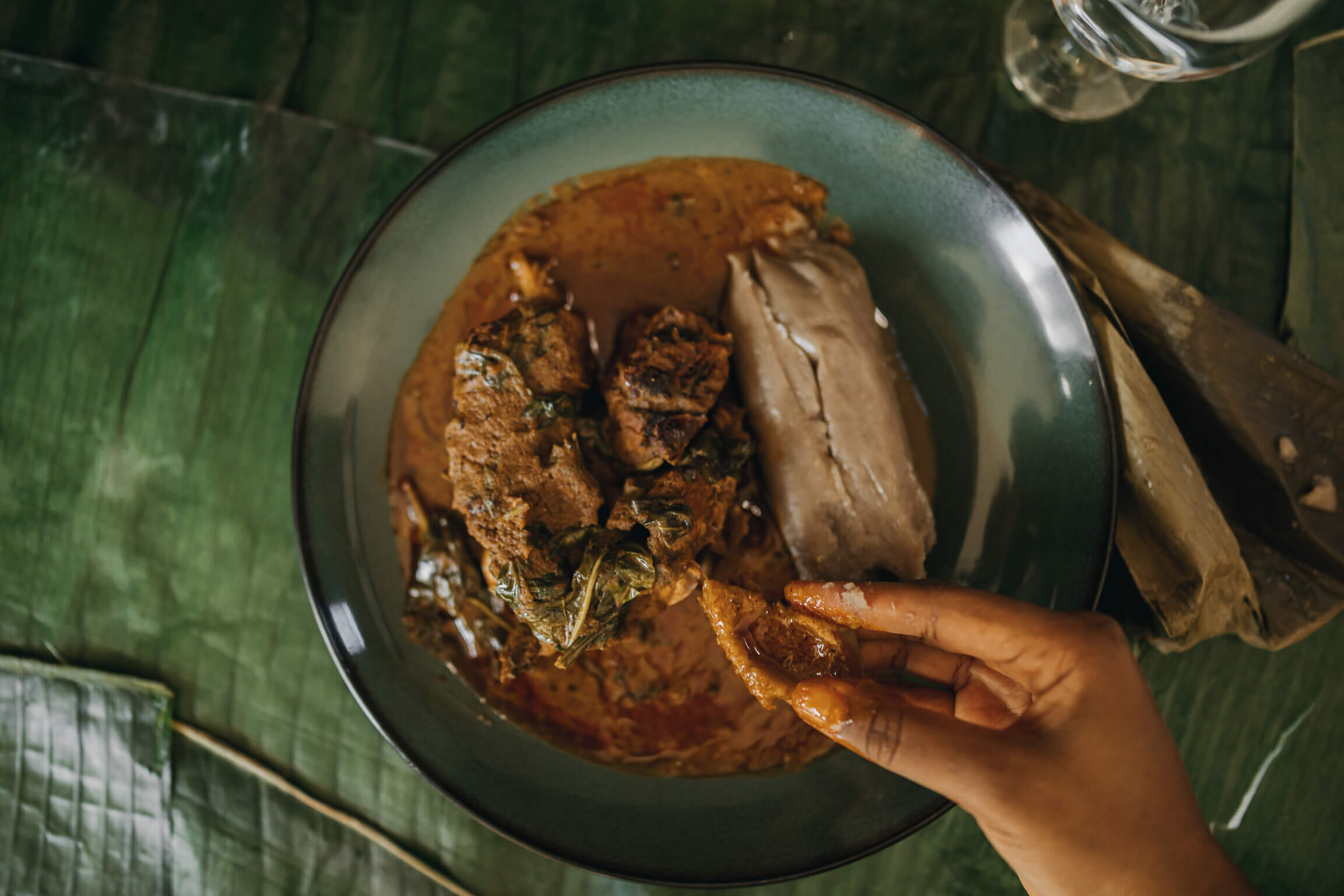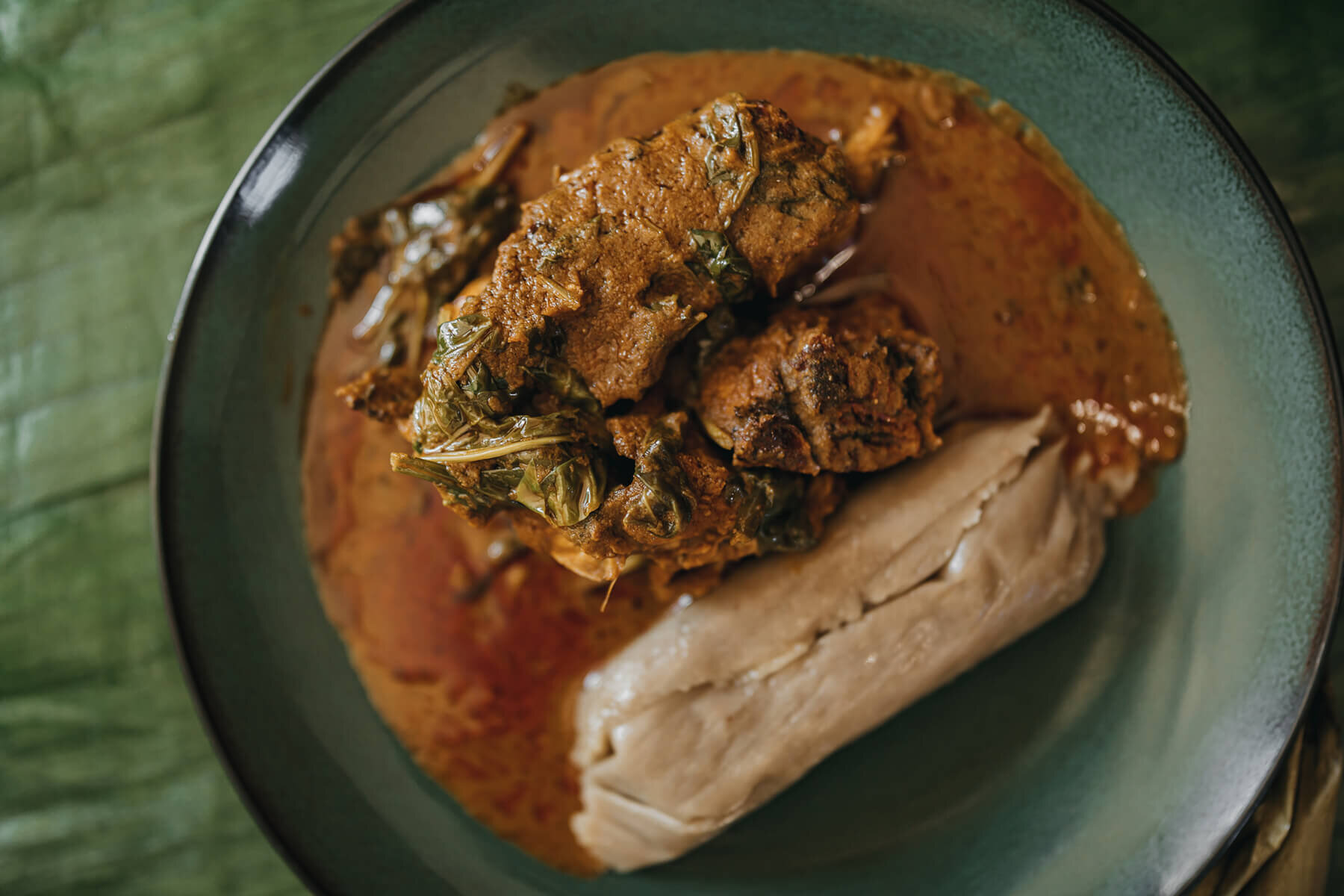Kwacoco And Banga Soup
Mount Cameroon also known as Mount Fako is located in the city of Buea, the ancestral land of the Bakweri ethnic group in the Southwest Region of Cameroon. Situated just a few kilometers from the Atlantic Coast of the Gulf of Guinea, Mount Cameroon is the highest mountain in West and Central Africa and amongst the top ten prominent mountains in Africa. The Mount Cameroon National Park is one of the biodiversity parks in Cameroon and a hotspot for ecotourism and sports events such as the Annual Mount Cameroon Race of Hope. For the Bakweri people, the national park has long been a resource for their livelihood. This is because the Bakwerians believe that Efasa-Moto (the god of the mountain) had blessed the rich and fertile volcanic soil to produce an abundance of crops. Among these crops are cocoyams and palm nuts that make up the two key ingredients in the traditional dish of the Bakweri people.
Kwacoco and Mbanga Soup which is traditionally known to the Bakwerians as Ngonya Mosaka is made from grated cocoyams and palm nut juice. To the Bakwerians, grated cocoyam when it's cooked (Kwacoco) is like fufu that needs to be eaten with soup. Mbanga Soup is made from freshly extracted palm nut juice from country Mbanga (organic grown palm nuts characterized by a large seed with small flesh). It is seasoned with spices, accompanied with smoked fish from the Atlantic Ocean, and garnished with fresh leafy vegetables. The taste of the Kwacoco together with the aromatic flavors from the indigenous species in the Mbanga soup plus the sizzling taste of Cameroon pepper is a match made in heaven that fills up the stomach and leaves room for more. As the Bakwerians say, “TIMBA NA BUSSA'' - Go and Come Back to Eat More. The deliciousness of this dish will make you crave for more finger licking experience.
Yes! I can testify to this when I was a student at the Presbyterian Comprehensive Secondary School Buea which is located at the foot of Mount Cameroon where I learned some cooking techniques in my Food and Nutrition Course. For five years, I had the opportunity to feast on this delicious dish prepared by the Bakweri mothers whenever I visited the local restaurants. Since then, I continue to “TIMBA NA BUSSA'' by preparing the dish even though I am thousands of miles away from Cameroon. Now, let’s enjoy this dish together! To join me, click play on the video below to cook along with me or scroll past the video to follow the written instructions.
Dish: Kwacoco/Ekwacoco and Mbanga/Banga Soup/Ngonya Mosaka/Timbana na Bossa
Country: Cameroon
Geographic Location: Buea, Southwest Region Cameroon
Ethnic Group: Bakweri
Diaspora Connection: FAKO AMERICA
K W A C O C O A N D B A N G A S O U P
Ingredients
b. 800gram Palm Nut Paste or 2Ibs Fresh Palm Nut Fruits
c. 4 Large Pieces of Smoked Barracuda or Smoked Fish of Choice
e. 1 Whole Alligator Pepper
f. 1 Leaf Manjuweli
h. 2 Habanero Pepper
i. 1 Large Bunch Spinach or Fresh Water Leaves or a Vegetable of Choice
j. 2 Small Pieces of Four Cornered Spice
k. 1 Whole or ¼ Teaspoon Country Onion-Ground
l. 2 Whole Pebbe
m. 2 Index Finger Size Ginger
n. ½ Medium Size Onion
o. 2 Cloves Garlic
p. Bouillon
q. Salt
How to prepare the Kwacoco
NOTE: Direct skin contact with raw cocoyams may cause itchiness for some people. It is advised to wear rubber gloves when completing the following steps.
1.Peel the cocoyams with a peeler or a sharp knife.
2. Thoroughly wash the cocoyams until they're clean and let them sit in a bowl of clean water.
3. Grate the cocoyams to form the cocoyam paste and add a pinch of salt and ¼ cup of water.
Click here for visual directions for step 1-3
4. Aerate the cocoyam paste by continuously beating to reach a fluffy texture.
5. Treat the banana or plantain leaves by gently placing one sheet at a time on top of the flames without allowing it to burn.
Click here for alternative method on how to treat banana leaves
Note: In the absence of leaves, line the inside of an aluminum foil with parchment paper and wrap the Kwacoco as directed in the steps below.
6. Scoop about a cup of the cocoyam paste and place on the treated leaves and wrap by rolling the leaves and folding both ends to prevent the paste from spilling.
7. Place the wrapped bundle into the pot and add water and cook on medium heat for 2 hours. Add more water if needed and cook until the kwacoco is done.
How to prepare the Banga Soup
Option 1: Extracting Pulp from Palm Nut Fruits.
1. If using the fresh palm nuts. Wash the nuts thoroughly and remove debris.
2. Place the nuts into the pot, add water to reach just above the level of the nuts and boil until it becomes soft.
3. Remove the palm nuts from the pot and place into a mortar while it's hot and then pound to release the pulp.
4. Transfer the pounded nut into a bowl and add hot water. Mix well then sift to filter the pulp from the nuts fibers.
5. Use the pulp to cook the banga soup as directed on following steps.
Option 2: Using Palm Nut Paste
1. Pour the palm nut paste into a clean pot and add 10 cups of hot water. Mix well until it’s smooth then cook on medium heat to bring to a boil.
2. Blend the alligator pepper, black pepper, four cornered spice, pebbe, ginger, garlic and onion until it forms into a puree and set aside.
3. Just when the palmnut soup begins to thicken, add the spice blend, smoked fish, crayfish, salt, bouillon and the manjuweli. Stir gradually not to break the fish. Set the stove on medium to low heat and cook for 15minutes.
4. Add the spinach or water leaves into the pot and cook for an additional 10 minutes on low heat. Add water if needed to your desired consistency. Then cook on low heat for an additional 5 minutes.
Add Manjuweli to Banga soup.
5. Serve by unwrapping the kwacoco from the leaves, place it into a bowl and add the palm nut soup with the smoked fish. Enjoy this fingerling licking dish with a cool drink of your choice.
As the Bakwerians will say, “TIMBA NA BUSSA” - Go and Come Back to Eat More
The deliciousness of this dish will make you crave for more.






